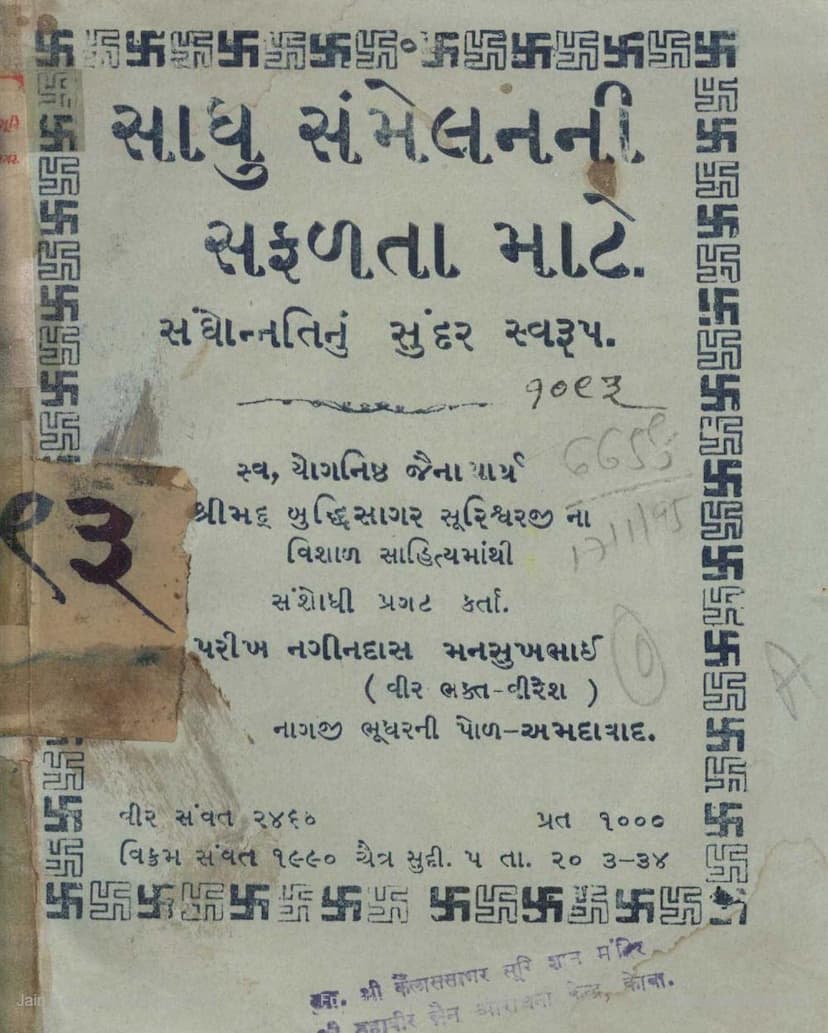Sadhu Sammelanni Safalta Mate Vikram Samvat 1990 Year 1934
Added to library: September 2, 2025

Summary
Here's a comprehensive summary of the Jain text "Sadhu Sammelanni Safalta mate Sadhunnati nu Sundar Swarup" by Nagin Mansukhbhai Parikh:
This book, published in Vikram Samvat 1990 (1934 AD), is dedicated to exploring the principles and practices that lead to the success of Sadhu Sammelans (gatherings of Jain monks) and the overall progress (Sadhunnati) of the Jain faith. The author, Nagin Mansukhbhai Parikh, presents this work as a distillation from the vast literature of the late Yoganishtha Jain Acharya Shrimad Buddhisagar Surishwarji.
The central theme of the book revolves around the vital role of Sadhus in upholding and advancing the Jain religion. The text emphasizes the profound respect and reverence due to monks who dedicate their lives to Jain principles, knowledge, detachment, and sacrifice. They are described as the breath of the Jain community, the beauty of the nation, and spiritual leaders.
The book highlights several key areas for the successful functioning and progress of the Jain community, with a strong focus on the conduct and responsibilities of Sadhus:
1. The Importance and Role of Sadhus:
- Sadhus are portrayed as the torchbearers of Jainism, embodying knowledge, renunciation, and compassion.
- They are seen as instrumental in spreading the teachings of Jainism, particularly the principles of Ahimsa (non-violence) and compassion.
- The text asserts that the progress of Jainism is directly linked to the dedication and righteous conduct of its Sadhus.
2. Criticisms and Suggestions for Improvement within the Jain Community:
- Internal Disunity and Conflict: A significant portion of the book addresses the detrimental impact of internal divisions, disagreements, and the tendency of different Jain sects (Gachhas) to criticize and undermine each other. This disunity is identified as a major obstacle to the progress of Jainism.
- Misuse of Intellectual Prowess: The author laments that the intellectual capabilities of Jain monks and laypeople are often wasted in debating and refuting each other's beliefs instead of focusing on constructive efforts for the community's growth.
- Need for Modernization and Adaptability: The book stresses the importance of adapting Jain practices and teachings to suit the current times (Desh-Kaal-Anusare). Old laws and methods need to be re-evaluated and updated by Jain Acharyas to ensure real progress.
- Lack of Strong Leadership and Organized Structure: The text points out the absence of effective organizational structures and proactive leadership within the Jain community, unlike in other religious traditions.
- Importance of Unity and Collaboration: The core message for the monks is to shed their differences, embrace unity, and work collaboratively under the guidance of their Acharyas for the betterment of the Jain faith.
- Addressing External Challenges: The book acknowledges the need for the Jain community to unite and defend its principles against the encroachment of other religions.
3. Recommendations for Sadhus and the Four-Fold Jain Community (Chaturvidh Sangh):
- Conduct of Sadhus:
- Adherence to vows and principles, including detachment from possessions, control over senses, and avoidance of temptations.
- Living a life of renunciation and spiritual discipline.
- Focusing on self-improvement through scriptural study and contemplation.
- Promoting unity and harmony among themselves and with the lay community.
- Avoiding gossip, criticism, and factionalism.
- Embracing a spirit of service and dedication to the Jain dharma.
- Maintaining purity of conduct and avoiding worldly entanglements.
- Role of Acharyas (Spiritual Leaders):
- Acharyas have a crucial role in guiding the community, resolving disputes, and adapting teachings for modern times.
- They need to foster unity and collaboration among various Gachhas.
- The establishment of Sadhu Pathshalas (monastic schools) and Sadhvi Pathshalas (nuns' schools) is strongly recommended for proper education and training.
- Acharyas should lead by example and promote a spirit of mutual respect and understanding.
- Role of Lay Jains (Shravaks and Shravikas):
- Lay Jains are encouraged to actively support the activities of Sadhus and Acharyas.
- They are urged to contribute financially and through service to the progress of the Jain community.
- The importance of raising the number of Jain followers through effective religious education and propagation is emphasized.
- The book calls for the establishment of institutions that provide quality education to Jain children, instilling them with Jain values.
- Lay Jains should strive for unity, mutual support, and a broad perspective.
- Organizational Reforms:
- The text advocates for a unified organizational structure for the Jain community, bringing together all Gachhas and followers.
- Regular meetings and discussions at various levels are encouraged to devise strategies for progress.
- The efficient management of Jain trusts and institutions is crucial.
- The book suggests that financial resources should be strategically utilized for the upliftment of the community, including education and welfare.
4. Specific Calls to Action:
- Unity among Gachhas: The author repeatedly stresses the need for Gachhas to set aside their differences and unite for the common good of Jainism.
- Modern Interpretation of Scriptures: Jain Acharyas are urged to interpret ancient scriptures in a way that is relevant and beneficial to the present generation.
- Promoting Jainism: The book emphasizes the importance of actively propagating Jain principles and values to increase the number of followers.
- Ethical Conduct and Self-Reflection: Sadhus are encouraged to introspect and maintain the highest standards of ethical conduct.
Overall Message: The book is a passionate plea for unity, reform, and proactive engagement within the Jain community. It highlights the challenges faced by Jainism in the modern era and provides a roadmap for its resurgence, with the success of Sadhu Sammelans and the overall progress of the faith being contingent on the collective effort, spiritual discipline, and united action of all its members, especially its monastic leaders. The author believes that by embracing these principles, Jainism can thrive and continue to spread its message of peace and righteousness across the world.